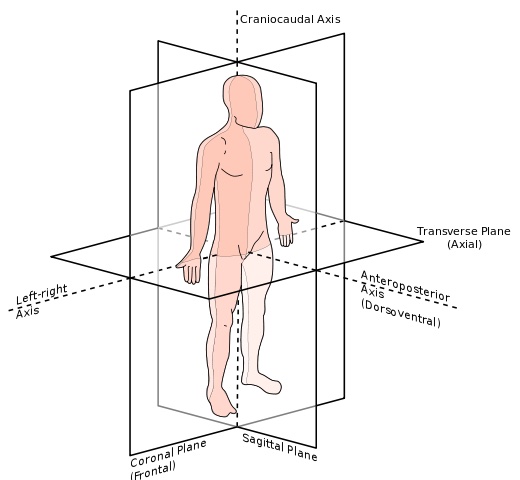8 Describing Motion and Movements
Amanda Shelton
Before we can begin to describe movements, it is important that we first identify the potential planes of motion and axis of rotation that movements can occur within.
Planes of Motion
We have three planes of motion:
- Frontal (coronal)
- Sagittal
- Transverse

The frontal plane separates the body into front and back. The sagittal plane separates the body into right and left sides. The transverse plane separates the body into top and bottom. For all of our different planes of motion it is important to consider that these planes do not exist in just one spot that cuts through the body, like our string example for the midline of our body in the previous chapter did, instead these planes can exist throughout the body but always in the same direction.
Axis of Rotation
From our planes of motion we can begin to expand on the axis of rotation that can occur within each of those planes. When we think about our axis of rotation we can think of them movements that follow along the invisible plane that exists in the plane of motion.
| Planes of Motion | Axis of Rotation |
| Frontal (Coronal) | Left-Right or Coronal |
| Sagittal | Anterior-Posterior or Dorsoventral |
| Transverse | Longitudinal or Cranialcaudal |
From these axes of rotation, we can identify specific movement patterns that will occur within these planes of motion as well.
Axes and Joint Motions
Human movement is described in reference to one of the planes mentioned above. Though movement is usually not restricted to one direction, a movement can be described an predominately on one plane. Watch this video to learn about anatomical motions.
Sagittal Plane Movements
- Flexion is a bending movement in which the relative angle between two adjacent segments decreases
- Extension is a straightening movement in which the relative angle between two adjacent segments increases
- Hyperextension refers to a joint moving beyond the normal state of extension in reference to anatomical position
- Dorsiflexion refers to movement that pulls the toes up towards the knee
- Plantarflexion refers to movement that points the toes down
Frontal (Coronal) Plane Movements
- Abduction movement on the frontal plane away from the midline of the body
- Adduction movement on the frontal plane towards the midline of the body
- Scapular retraction is movement of the shoulder blades closer together/towards the midline of the body
- Scapular protraction is movement of the shoulder blades away from the midline of the body
- Scapular depression is inferior movement of the shoulder blades
- Scapular elevation is superior movement of the shoulder blades
- Inversion refers to movement of the sole of the foot towards the midline of the body
- Eversion refers to movement of the sole of the foot away from the midline of the body
* Motions of the shoulder blade are important for fitness professionals to familiarize themselves with to ensure proper movement of the shoulder complex
Transverse Plane Movements
- Internal rotation is the rotation of a joint towards the midline of the body
- External rotation is the rotation of a joint away from the midline of the body
- Horizontal abduction refers to movement of the arm or thigh in the transverse plane from an anterior position to a lateral position
- Horizontal adduction refers to movement of the arm or thigh in the transverse plane from a lateral position to an anterior position
- Pronation is rotation of the hand bringing thumbs towards the midline of the body
- Supination is rotation of the hand bringing thumbs away from the midline of the body
the imaginary flat surface that runs through the body that help us describe and dictate movements
the imaginary plane of motion that separates the body into front and back
the imaginary plane of motion that separates the body into left and right
the imaginary plane of motion that separates the body into top and bottom
the axis is the imaginary line that lies at a 90 degree angle from a given plane of motion creating rotational movements along that plane
a bending movement in which the relative angle between two adjacent segments decreases
a movement where the relative angle between two adjacent segments increases
a joint moving beyond the normal state of extension, in reference to the anatomical position
movement that pulls the toes up toward the knee
movement that points the the toes down away from the body
movement on the frontal plane, toward the midline of the body
movement of the shoulder blades (scapula) closer together, toward the midline of the body
movement of the shoulder blades (scapula) away from the midline of the body, following the angle of the ribcage
inferior movement of the shoulder blades (scapula)
superior movement of the shoulder blades (scapula)
movement of the sole of the foot toward the midline of the body
movement of the sole of the foot away from the midline of the body
rotation of a joint toward the midline of the body
rotation of a joint away from the midline of the body
movement of the arm or thigh in the transverse plane from and anterior position to a lateral position
movement of the arm or thigh in the transverse plan from a lateral position to an anterior position
rotation of the hand bringing the thumb toward the midline of the body or palm toward the back of the head
rotation of the hand bringing thumbs away from the midline of the body or palms toward the face

